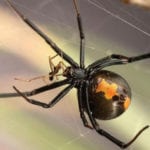 Mysteries
Mysteries  Mysteries
Mysteries  History
History 10 Surprising Stories About the Texas Rangers
 Humans
Humans 10 Philosophers Who Were Driven Mad by Their Own Theories
 Miscellaneous
Miscellaneous 10 Video-Game-Worthy Weapons and Armors from History
 Weird Stuff
Weird Stuff 10 Psychics Who Accurately Predicted Wartime Events
 The Arts
The Arts 10 Pieces of Art Inspired by a Broken Heart
 Health
Health 10 Science Fiction-Sounding New Medical Treatments
 History
History 10 Surprising Facts About the Father of Submarine Warfare
 Space
Space Ten Astonishing New Insights into Alien Worlds
 Weird Stuff
Weird Stuff 10 Bizarre Summer Solstice Rituals Still Practiced Today
 Mysteries
Mysteries Top 10 Haunting Facts About the Ghost Ship MV Alta
 History
History 10 Surprising Stories About the Texas Rangers
 Humans
Humans 10 Philosophers Who Were Driven Mad by Their Own Theories
Who's Behind Listverse?

Jamie Frater
Head Editor
Jamie founded Listverse due to an insatiable desire to share fascinating, obscure, and bizarre facts. He has been a guest speaker on numerous national radio and television stations and is a five time published author.
More About Us Miscellaneous
Miscellaneous 10 Video-Game-Worthy Weapons and Armors from History
 Weird Stuff
Weird Stuff 10 Psychics Who Accurately Predicted Wartime Events
 The Arts
The Arts 10 Pieces of Art Inspired by a Broken Heart
 Health
Health 10 Science Fiction-Sounding New Medical Treatments
 History
History 10 Surprising Facts About the Father of Submarine Warfare
 Space
Space Ten Astonishing New Insights into Alien Worlds
 Weird Stuff
Weird Stuff 10 Bizarre Summer Solstice Rituals Still Practiced Today
10 Absurd Sleep Habits Of Wild Animals
As far as we know, every animal must rest at some point. We didn’t used to think so. Some animals, like the dolphin or bullfrog, simply have sleep habits that look an awful lot like not sleeping to the human eye.
But even those that don’t sleep at all still rest. Most insects enter into a state called torpor, which significantly reduces their awareness. Even bacteria have been shown to follow a circadian rhythm, cycling through different levels of activity based on changes in the light.
Sleep is still somewhat mysterious to us. We know that it is somehow linked to memory and we die when we miss enough of it. That covers a lot of what we know about our own sleep.
We know even less about what sleep does for each member of the animal kingdom. We do know that the need for sleep tends to exist in a delicate balancing act with the need to not become some other creature’s midnight snack. Sometimes, that means that animals develop bizarre sleep habits that we find hard to imagine copying.
10 Apes Sleep Like We Do
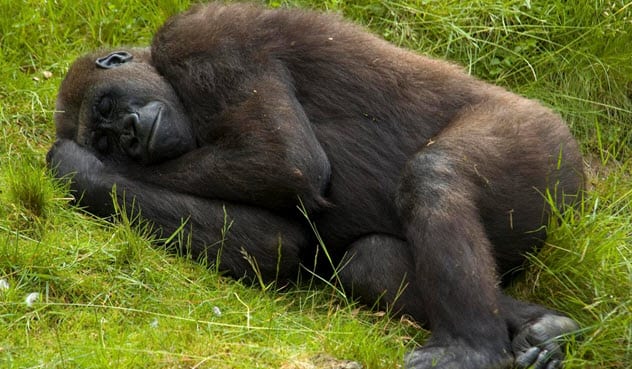
Every species of great ape sleeps in some kind of bed, whether those are the platforms that wild apes build in trees or the plush mattresses that humans nestle into in the comfort and safety of our own homes.
Lesser apes and monkeys don’t do this, opting instead to sleep sitting on a tree branch while they wobble and sway and occasionally waking up to check for predators. This difference is thought to have been instrumental in the evolution of great apes and, eventually, humans.
As great apes grew bigger, it became harder for them to find branches that could easily and comfortably support them. When the first great ape built a platform to sleep on sometime between 23 to 5 million years ago, the benefits of doing so became apparent.
Those who slept on platforms could shelter higher and were a bit more hidden from predators. At the same time, they were able to rest out of the range of mosquitoes. But the best advantage was that great apes could now get restorative deep sleep which helped enable the improved cognitive functions needed to grow bigger and better brains.[1]
9 Elephants And Giraffes Sleep Standing Up
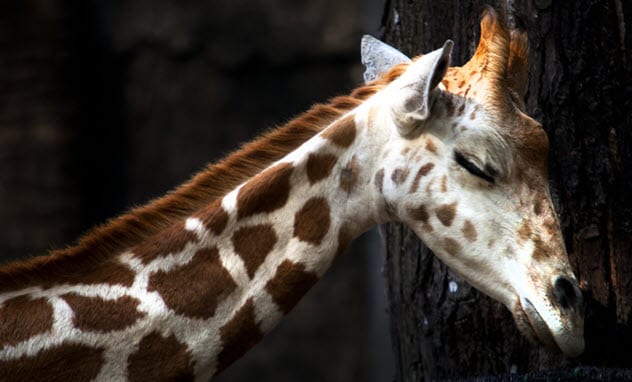
As large prey animals, elephants and giraffes are the opposite of great apes when it comes to sleep. They cannot hide away to rest and need to be ready to run at any moment. So they have naturally evolved to sleep standing up.[2]
Sometimes referred to as a “stay apparatus,” these animals have a knee that locks in place so that they don’t have to rely on their muscles to stay standing in sleep. They share this mechanism with horses, cows, and even birds.
These animals still have to lie down sometimes, though. While standing, they cannot enter into REM sleep. Even though these two creatures require very little REM sleep, they still need it.
An elephant needs REM sleep about once every three to four days and only for about 30 minutes at a time. If they stay on the ground any longer than that, their internal organs may give out under the pressure of their immense weight.
A giraffe sleeps about 30 minutes a day. They tend to get this sleep in very short bursts, usually no longer than five minutes at a time.
8 Dolphins Sleep With One Eye Open
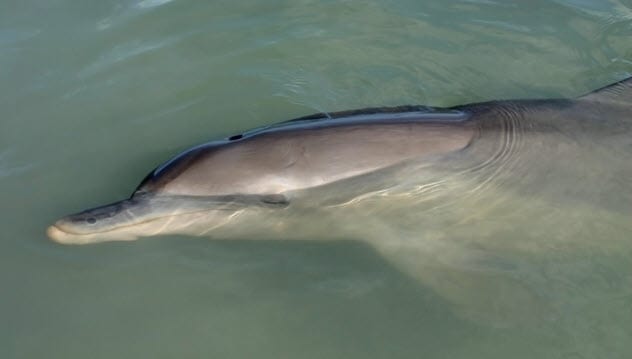
As well as other cetaceans, the dolphin is another creature that can’t exactly lie down to sleep. Most marine mammals have to be on the lookout for predators, but they also have to contend with the fact that they need to consciously breathe oxygen to live.
Unlike humans, dolphins breathe voluntarily and can’t become unconscious without the risk of drowning. Finally, dolphins are warm-blooded mammals living in the cool waters of the ocean. They need to keep moving to keep up their body temperature. When an animal has to keep moving, there’s only one logical thing to do: Just sleep one-half of the brain at a time. Easy.
Unihemispheric slow-wave sleep allows dolphins to get the sort of restorative sleep needed by intelligent animals, but it isn’t just for cetaceans. Many species of birds, especially migratory ones, also engage in unihemispheric sleep.
Unlike migratory birds, dolphins don’t tend to cover large distances while half asleep. Many dolphins manage to hang near the surface or swim slowly, but all generally close one eye to sleep. Probably because of this habit, some have been observed sleeping while swimming in circles.[3]
7 Newborn Orcas Can’t Sleep
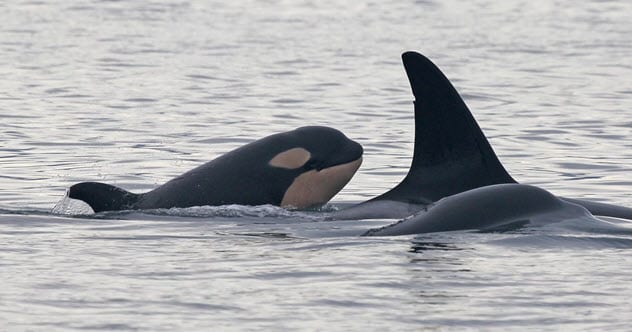
Orcas and other cetaceans don’t sleep for the first month after birth. Usually, adult orcas will sleep about 5–8 hours a day, but neither the mother nor her calf can sleep until 3–4 weeks after birth.
The mortality rate is extremely high for calves, so at least part of this is likely to keep predators away. Not many creatures are willing to contend with a mother orca defending her calf. However, there are a few more reasons that orca calves can’t sleep.[4]
The calf doesn’t have the muscle strength to keep up with the pod, and it doesn’t have the necessary blubber to stay warm and afloat. To stay alive, the calf needs to stay in its mother’s slipstream where it will be pulled along without getting separated.
As the adult orca must keep moving to generate that slipstream, she can’t sleep, either. Researchers also believe that orca mothers forgo the unihemispheric sleep that cetaceans rely on, too, as none have been observed to swim with an eye closed.
6 Ducks Sleep All In A Row
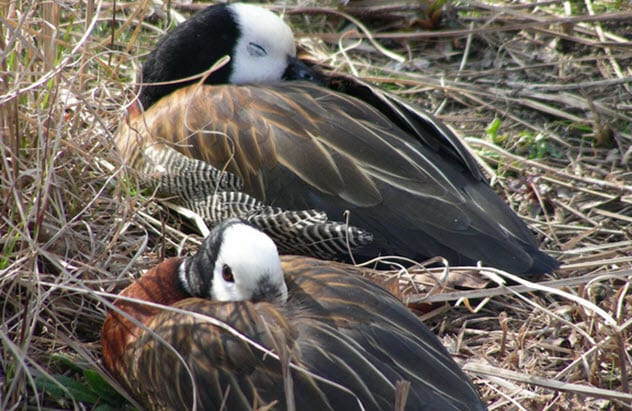
Unlike orcas, ducks aren’t keen to miss any of their beauty sleep. There’s a reason that to “get one’s ducks in a row” means to have one’s affairs and priorities in order. It turns out that ducks are pretty smart when it comes to catching a few z’s. They can engage in unihemispheric sleep, but they do so using an interesting strategy that wards off any predator looking for a fatty duck dinner.[5]
Ducks often sleep in a row where the ducks on either side sleep with the outward-facing eye open and one hemisphere of the brain alert. The ducks in the middle get to sleep both hemispheres while secure because of the lookout ducks, and the lookouts get to rest up a little at a time.
All the ducks benefit by getting some sleep without also getting eaten. We’re just hoping that they trade off for lookout duty sometimes.
5 Migratory Birds Power Nap
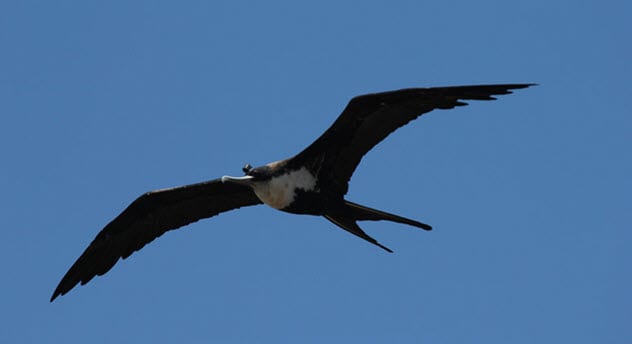
Scientists have theorized in the past that migratory birds sleep in midair because the only other explanation is that the birds simply do not sleep for weeks or months at a time. Recently, though, Niels Rattenborg from the Max Planck Institute and colleagues from other institutions have studied the sleep habits of frigatebirds. These creatures sleep about 12 hours a day when nesting on land but often spend weeks soaring over the ocean in search of food.
Their study found that the frigatebirds are indeed able to sleep in midair with one or both hemispheres of the brain and can enter into REM sleep without dropping. The birds can do this because they only sleep for a few minutes at a time and only for a few seconds when getting REM sleep. The birds also used their ability to sleep one hemisphere at a time to ensure that they didn’t knock into other birds while ascending and descending.[6]
4 Reptiles Might Dream
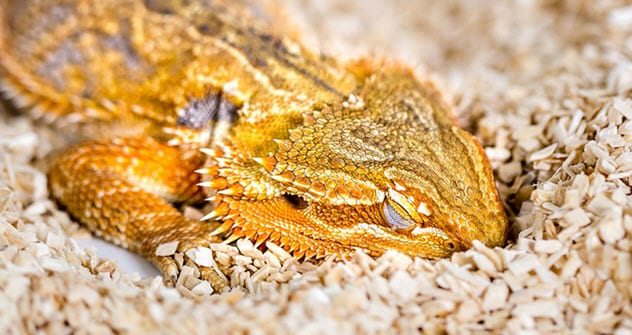
Until recently, the general consensus was that only mammals and birds experienced REM sleep. This is the kind of sleep thought to consolidate memories and the sleep that many creatures risk death to achieve daily. Reptiles, amphibians, insects, and amoebae were excluded from the dreamers.
This was puzzling from an evolutionary standpoint as birds are far more closely related to reptiles than to us. But, with the evidence available at the time, scientists just had to shrug and assume that birds and mammals spontaneously evolved to dream around the same time.
New research from Gilles Laurent from the Max Planck Institute for Brain Research in Frankfurt, Germany, had surprising results that may force us to revise that assumption. When researchers hooked bearded dragons up to an electroencephalogram (EEG), they noticed some very familiar sleep cycles.
The dragons studied went through about 350 80-second cycles per night that seemed simple in comparison to the four or five 90-minute ones that humans experience. Scientists now theorize that mammals, birds, and reptiles share a common ancestor that developed cyclical sleep about 300 million years ago.[7]
But what do reptiles dream about? Laurent said, “If I were an Australian dragon living in Frankfurt, I’d be dreaming of a warm day in the sun.”
3 Fish Aren’t Afraid Of The Dark
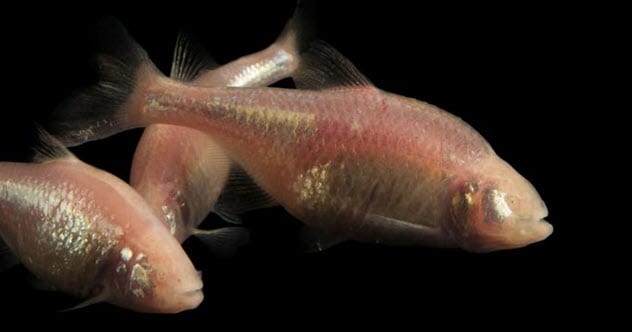
Emmanuel Mignot at Stanford University in Palo Alto, California, and his colleagues performed sleep studies using zebrafish with the hope that they would see whether the fish could suffer from insomnia or sleep deprivation. They found that the fish followed a simple circadian rhythm.
When lights are on, the fish don’t sleep at all. When they’re off, the creatures will nap if there is a sleep debt to pay up. For the fish, it’s far simpler than for mammals. Light triggers the release of a hormone that overrides the need for sleep until nighttime rolls around again. Lucky fish.
This isn’t the case for one particular species of fish, though. The eyeless Mexican cave fish experiences no circadian rhythm whatsoever. Damian Moran of the private company Plant and Food Research studied the eyeless Mexican tetra as well as its surface-dwelling counterpart by putting them both into fish treadmills where they could swim against a current constantly. The surface tetras used more energy under lights than in the dark, while the eyeless tetras didn’t change at all.
It makes sense that a creature that lives in total darkness and is eyeless doesn’t give a flying flip about light cycles, but the most interesting finding was what this meant for their energy use overall. Using less energy at night didn’t leave the surface tetras better off. Instead, they used 27 percent more energy than their eyeless cousins. This energy was spent revving up their metabolisms to expend more daytime energy and slowing it back down at night.[8]
2 Parrotfish Sleep In A Bubble
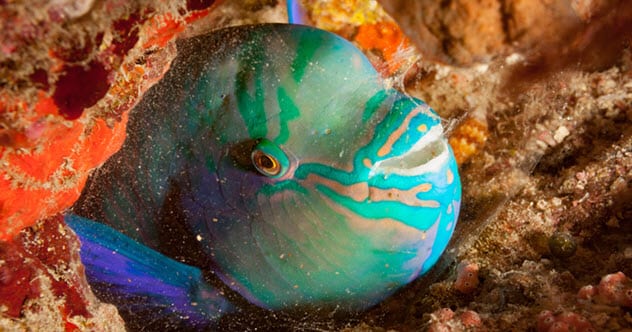 Parrotfish are already gunning for a top spot on the world’s strangest animal list considering that they crunch on coral reef and change their color and sex fairly often. But this fish isn’t stopping when it comes to sleeping.
Parrotfish are already gunning for a top spot on the world’s strangest animal list considering that they crunch on coral reef and change their color and sex fairly often. But this fish isn’t stopping when it comes to sleeping.
When the parrotfish settles in for a good night’s rest, it activates special glands in the gills to secrete a mucus bubble around itself. Scientists have long debated why the parrotfish does this, postulating that it may lower the chances of being eaten by eels or act as a kind of fishy sunscreen.
Alexandra Grutter from the University of Queensland is one scientist who thinks she knows why parrotfish sleep in a jelly cocoon. Fish who hang around the reef at night are vulnerable to tiny bloodsucking crustaceans called gnathiid isopods. During the day, cleaner fish nip these little ocean mosquitoes before they can latch on. At night, however, even cleaner fish have to sleep.
Grutter tested this theory by removing some sleeping parrotfish from their cocoons and leaving them vulnerable to gnathiids. The exposed fish were attacked mercilessly while the cocooned ones were largely ignored.[9]
1 Walruses Snooze By The Skin Of Their Teeth

A walrus can forgo sleep for up to 84 hours at a time. While plenty of animals go without much sleep for a long time, only walruses do so regularly and without any notable signs of sleepiness. This finding may force sleep researchers to reevaluate ideas of how much sleep a mammal needs. On land, a walrus can sleep deeply for up to 19 hours at a time, possibly to make up for their sleep debt.[10]
When not avoiding sleep like a college student cramming for finals, the walrus still acts much like a college kid by sleeping just about anywhere with no problem. When in water, walruses will sleep floating on the surface, lying at the bottom, or standing and leaning. These sleeps are short because a walrus needs to come up for air from time to time.
However, some enterprising walruses have figured out how to have the best of both worlds. They dig their massive tusks into an ice floe and drift off to sleep. Their head stays above water while the rest of their body is submerged, which must be super comfortable for an animal that’s never heard of brain freeze.
Renee Chandler is an Atlanta-based graphic designer and writer. She is currently coauthoring a project that you can preview and support at www.patreon.com/pterohog.
Read more fascinating facts about wild animals on 10 Times Wild Animals Saved Humans and 10 Animals We Failed To Domesticate.
